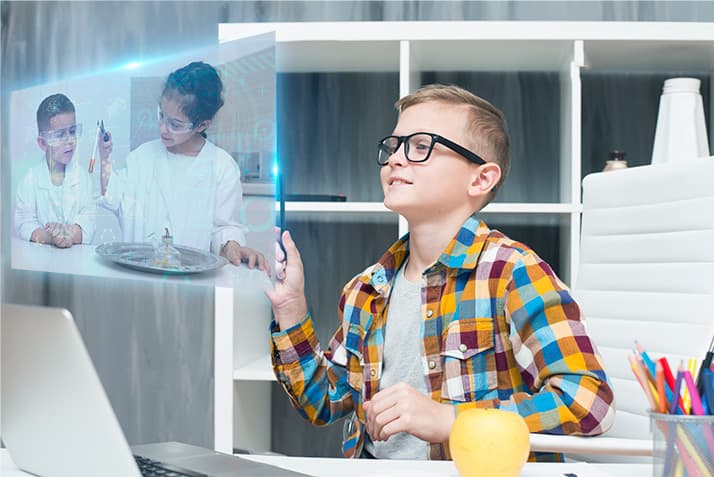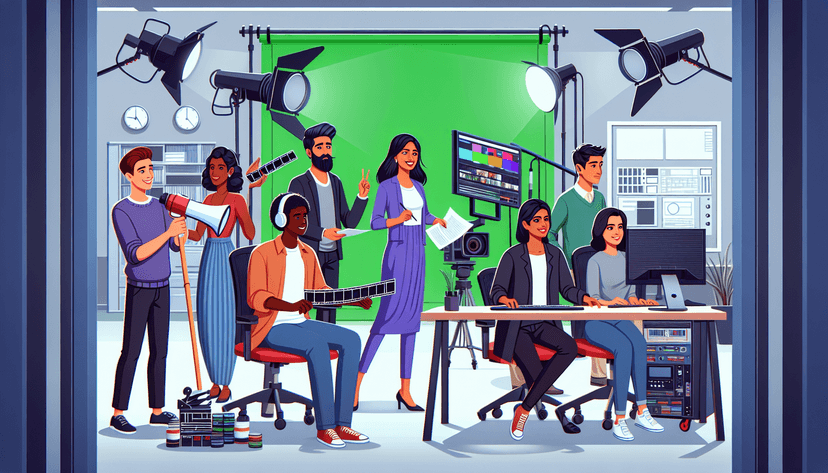Generative AI in education goes beyond making individual quizzes and tests with ChatGPT. It also impacts education and makes learning more engaging and personalized for learners. Today’s post explores AI trends in education in 2025.
The generated AI market's projected value in 2025 is US$62.72 bn, with an annual 41.53% growth rate (CAGR 2025-2030), resulting in a US$356.10 bn market volume by 2030.
Educational services are a major contributor to this massive progress. Undoubtedly, generative AI in education goes beyond generating individual quizzes and tests with ChatGPT. It also impacts education and makes learning more engaging and personalized for learners. Today’s post explores AI teachers and other AI trends that impact education this year.
AI Trends in Education: How Generative AI Revolutionizes Learning

Educational Content with AI Avatars
Producing quality content on a budget and saving time is a significant advantage of using AI tools in education, like Puppetry, which can create exciting, interactive, and engaging learning materials for learners.
AI tools allow educators to create quality content in a fraction of the time and cost of producing an eLearning video using traditional methods. Nevertheless, teachers and lecturers can make learning materials in minutes without spending much time on research.
How about consistency? AI avatars in education allow schools, universities, and other institutions to easily maintain quality consistency across topics and subjects.
AI Talking Heads for Teaching
Animated AI talking avatars can deliver lessons and presentations and improve student engagement.
These virtual avatars empower educational institutions to create video lessons, which are more affordable than hiring actors or having the lecturers themselves record the visual content.
You’ll be surprised at how easy creating AI tutors in the Puppetry Studio is. All you need is to upload your photo or use one of the sample puppets, write a script (or let our script generator create one for you), and then make an AI teacher video. Here’s a more detailed guide on how to create AI talking heads.

AI avatars can deliver lessons across subjects or topics in multiple languages. Today, students from Japan or other non-English-speaking countries can register for online courses even if they don’t speak English.
Without even saying, AI tools make the learning process scalable and flexible while improving accessibility for international students.
They also offer personalized learning, adapting content for students with different learning styles.
AI Tools for Art Learners
Generative AI in education improves how art students learn new painting methods, styles, and techniques. Advanced solutions also show them different resources like tutorials to practice and master different drawing methods.
In addition, art learners can use AI to find new ideas or look for inspiration. These AI platforms allow students to collaborate on projects and seamlessly combine art techniques. They can use these tools for design assistance by suggesting layouts, compositions, and color combinations.
Meanwhile, those not skilled at creating art can generate it with AI art tools for backgrounds, concept art, and other images to add visual appeal to presentations and assignments.
A few examples of these AI art tools are DALL E 3 (OpenAI), NightCafe Creator, Craiyon, and CF Spark. Meanwhile, Canva AI, a text-to-image generator that works with Canva's design program, is an AI tool optimized for poster creation.
AI for personalized learning

One of AI's most significant educational impacts is personalized learning. It can provide students with adaptive learning opportunities.
Learners have different learning styles—some prefer audio or video formats, while others prefer writing. Using AI products in education allows colleges and institutions to create affordable, high-quality content tailored to students' academic levels and backgrounds.
Generative AI helps improve a learner’s problem areas in addition to focusing on their academic strengths. This effectively addresses learning gaps.
AI-based platforms can gather data about learners' strengths, weaknesses, and learning patterns for appropriate customized exercises and content.
Studies reveal that learners who use AI-driven adaptive learning programs saw a 62% increase in test results.
Artificial intelligence offers individualized instruction by applying appropriate complexity and speed based on the student’s proficiency level to achieve their learning goals.
An example is Knewton, which, at its core, uses AI to customize educational content based on a student's individual needs. This paves the way for a personalized learning experience, making learning easier and more fun.
Knewton offers online courses in different subjects and works like a digital AI tutor who can determine a student's strengths. This allows learners to create study plans to stay motivated and focused.
Generative AI: Education for Everyone!
Speech-to-text and text-to-speech platforms allow learners with learning and physical disabilities or auditory and visual impairments to access education through adaptive study materials.
AI tools for education promote inclusivity and accessibility through different platforms and predictive text functions.
These tools help students with learning, hearing, and visual disabilities access learning by converting text into audio, providing captions, and offering other learning formats.
[Learning disability is a group of disorders affecting a broad range of functional and academic skills. A few examples are the ability to do math calculations, read, listen, speak, reason, organize information, spell, and write.]
Integrating AI Agents & Tutors
AI agents are redefining education this year: It will transform how students learn, and teachers manage classrooms.
Such intelligent assistants will be integrated deeply into learning management systems, adjusting education content based on a student’s performance to create personalized learning experiences.
AI tutors can give instant feedback, provide insights on mistakes, guide learning paths, and provide on-demand 24/7 student support. The customization AI provides can help students stay focused and boost retention rates.
AI: Educator and Student Support
For Educators
AI transforms education not only for students but also for educators in how they teach and manage classrooms. It can automate routine tasks and offer data-driven insights, allowing them to focus on better things like student engagement and personalized instruction. Areas where generative AI tools can support teachers include -
-
Grading tests (or some open-ended assignments with natural language processing or NLP)
-
Admin tasks, such as scheduling, generating reports, and tracking attendance
-
Answering common student questions (chatbots)
-
Adaptive learning programs can adjust lesson complexity based on student progress.
-
Creating custom lesson plans for each learning style
Tools like Puppetry allow teachers to develop a personalized AI avatar for different presentations and videos.
Socratic by Google is highly accurate on STEM subjects. It can provide instant explanations on complex topics and help students solve Math problems.
For Students
Specific tools act like intelligent assistants, guiding students in academics and providing personalized assistance on-demand, like AI homework helpers. Here are the areas where AI provides student support.
-
AI chatbots can answer student questions anytime, so there is no need to wait for human educators to respond. They can offer quick explanations on complex topics.
-
AI can help students choose courses according to future career goals, interests, and academic progress and give recommendations for electives.
-
AI-powered student assistants can aid in admin tasks and offer step-by-step instructions.
-
Other AI benefits include tracking student performance, creating study plans, and helping manage time and deadlines.
On mental health and well-being

In mental healthcare, AI talking heads can ask questions, gauge responses for an initial mental health assessment, and offer ongoing support with stress management tips, exercises, and mood check-ins.
Some institutions use mental well-being support tools to check students’ mental well-being, suggest counseling services, and offer stress management resources.
Hey Sunny, an AI chatbot from Arizona State University, helps learners adjust to college life. Tools like these help students develop positive mental health habits and behaviors.
AI in Education: Final Thoughts
AI is a transformative tool for facilitating interactive simulations, promoting collaborative, interactive, and inclusive learning, and making education accessible, fun, and engaging. It’s undoubtedly a game-changer that will drive education into a different era where personalization, efficiency, and innovation play a significant role in enhancing student performance and improving educator productivity.






